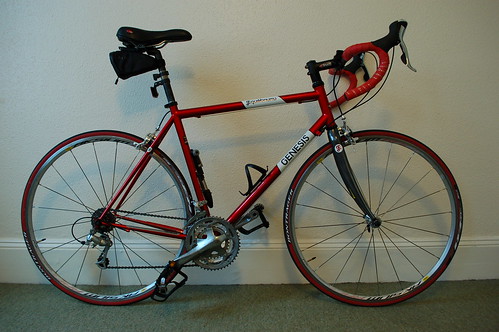This will be the last post on this blog, as I think I've covered everything that I wanted to. Indeed, if it hadn't been for something that happened after I finished the London to Paris ride, I'd be finished already.
Speaking of which, the ride. I was part of a group of 140 cyclists, and we covered the distance over four days. Day 1 was 95 miles; day 2, 75 miles; day 3, 70 miles; with 60 miles on the final day. Day 3 may be the most I've ever enjoyed cycling in my life. I'm also pleased to say that, over the 295 miles, I had not a single problem with the bike at all - no punctures, pinch flats, brake issues or rough shifts. It was truly the dream machine I hoped it would be.
So, 295 miles with not a problem - wonderful. After arriving in Paris, I dropped the bike off for it to be returned to London by truck and ferry, while I soaked my aching legs in a nice hot bath. Sad to say, when I collected the bike in London, it had two dirty big gouges in the paintwork of the head tube:
Now, I'm not one for being overly precious about things, and a bike is a working machine which will pick up the odd scratch and scrape, but these seemed like two fairly hefty chunks, and I was naturally worried I'd end up with a rust problem if I didn't get it seen to.
First stop were all of my trusted local bike shops - I was sure one of them would be able to help me out, but sadly not. The best I got from them was the offer of sending the bike off to a repair shop in Bristol for a couple of weeks. I tried other shops in London, and the story was more or less the same - inconvenient locations and long waiting times.
I tried a few car bodywork repair shops, too, but none of them were interested in taking on a small job like this, and would've charged me car prices for it. Eventually it dawned on me that, if I wanted the scratches repaired, I was going to have to do it myself.
Paintwork was never on my agenda when I started this project. On occasion, I've had to paint the odd wall in my flat, but the outcome has always been a bit like this. Faced with no alternative, however, I went over to Halfords, not quite sure what I needed, and came back with:
- A spray can of red primer
- A spray can of red paint for an Audi
- A spray can of lacquer
- A packet of paint preparation wipes
- Some fine grit wet and dry sandpaper
- Masking tape
Thus equipped, I took the bike outside and set to work. First was the masking tape, masking off as much of the down and top tubes as I thought I'd need to, the crown area of the forks, and the cables. I left the scratched area exposed in a rectangle, to give a nice clean finish.
I then sanded, cleaned and dried the scratched area, and applied a couple of coats of primer, at 15-minute intervals. The nozzles on the spray cans weren't especially ideal for the sort of detailed work I was attempting to do, having been designed for use on larger areas, but it worked pretty well.
Following that, I went to the pub for a bit, and had a cracking Indian lunch at Bangalore Express, while the primer dried. On my return, I sanded and cleaned again, and then put on three or four coats of paint, and left that overnight to dry.
The next morning ... sand, clean, lacquer, repeat. And then ... the moment of truth ...
... peeling off the masking tape ...
Well, it's not exactly a good colour match, but it's covered up the scratches pretty well, which is what I was looking for. The marks you can see above and below the painted area are just the leftovers of the adhesive from the masking tape, but some sugar soap will take care of that.
And so concludes Cycle Maintenance for the Mechanically Gifted. Thank-you for reading!












